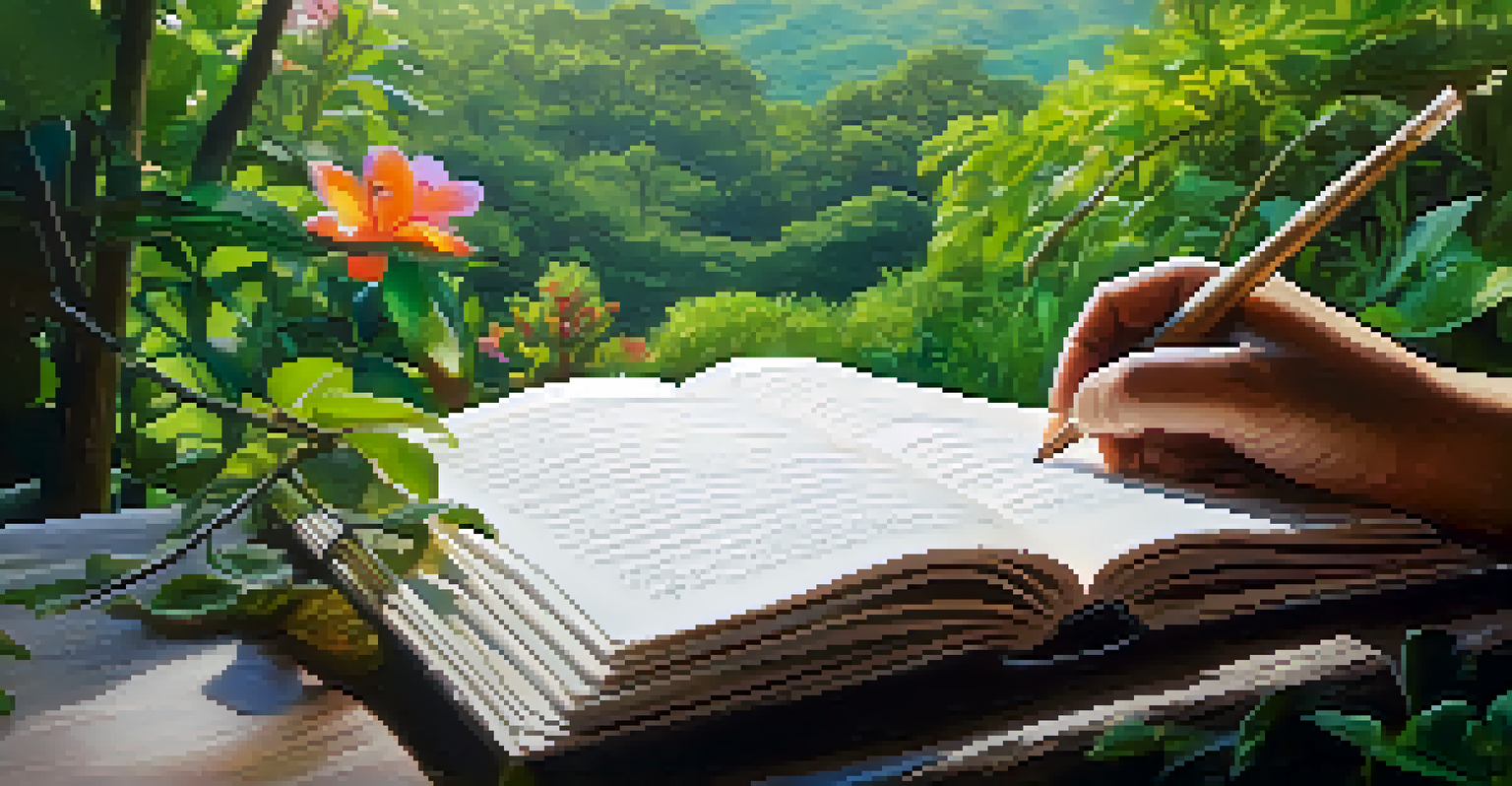Ayahuasca in Poetry: Exploring the Depths of Experience

Understanding Ayahuasca: A Gateway to the Soul
Ayahuasca is a powerful plant medicine traditionally used by indigenous cultures in the Amazon. Known for its psychoactive properties, it offers profound insights into the self and the universe. This unique brew, made from the Banisteriopsis caapi vine and other plants, is often consumed during ceremonial rituals.
The poet's job is to find a place where the spirit can breathe.
The experience of Ayahuasca can transport individuals into a deeply introspective state, where emotions and thoughts intertwine. This journey often reveals hidden layers of consciousness, allowing participants to confront their fears, desires, and memories. It's in this altered state that many find the inspiration that fuels their creativity.
Poets, in particular, have turned to Ayahuasca as a source of artistic expression. The vivid imagery and emotional depth experienced during an Ayahuasca ceremony often find their way into poetry, creating a bridge between the mystical and the tangible.
The Connection Between Ayahuasca and Creativity
Many artists, especially poets, report heightened creativity after an Ayahuasca experience. This surge in creative energy can be likened to the sensation of a dam breaking, releasing a flood of inspiration. The insights gained during the ceremony often manifest in artistic forms, allowing for a new way of seeing the world.

For instance, renowned poet Allen Ginsberg famously explored his experiences with psychedelics, including Ayahuasca, which led to a richer, more profound poetic voice. This connection highlights how altered states of consciousness can unlock creative potential and offer new perspectives.
Ayahuasca Unlocks Creative Potential
Many artists, especially poets, experience heightened creativity and new perspectives following Ayahuasca ceremonies.
Ultimately, Ayahuasca can serve as a catalyst for artistic expression, pushing poets to delve deeper into their emotions and experiences. This exploration can lead to profound works that resonate with readers on multiple levels, making the personal universal.
Themes of Healing and Transformation in Ayahuasca Poetry
One of the most prevalent themes in poetry inspired by Ayahuasca is healing. The plant medicine is often associated with deep emotional and psychological healing, allowing individuals to process trauma and pain. Poets weave these healing narratives into their verses, creating a tapestry of resilience and growth.
Creativity is the way I share my soul with the world.
The transformative nature of Ayahuasca journeys can lead to a rebirth of sorts, where poets express their newfound perspectives on life. This theme of transformation echoes throughout many works, as individuals articulate their journeys from darkness to light. Such poetry can be a powerful reminder of the potential for change within us all.
Through vivid imagery and evocative language, poets capture the essence of their transformative experiences. Readers are invited to witness this journey, fostering a sense of connection and understanding that transcends individual experiences.
Imagery and Symbolism in Ayahuasca-inspired Poetry
The use of imagery and symbolism is a hallmark of poetry, and Ayahuasca experiences provide rich material for this. Poets often draw upon the vibrant visuals and sensations encountered during their journeys, creating a lush landscape of words. This imagery not only captivates readers but also serves as a portal into the mystical realms of consciousness.
Common symbols in Ayahuasca poetry include nature, animals, and cosmic elements, reflecting the interconnectedness of all beings. For example, a poet might describe a serpent as a symbol of transformation, embodying the shedding of old identities. Such symbols resonate deeply with readers, allowing them to tap into their interpretations.
Healing Themes in Ayahuasca Poetry
Ayahuasca poetry often explores themes of emotional healing and transformation, reflecting journeys from trauma to resilience.
Ultimately, the imagery in Ayahuasca poetry acts as a bridge between the internal and external worlds. It invites readers to explore their own experiences and emotions, fostering a deeper understanding of the human condition.
Cultural Context: Ayahuasca and Poetry in Indigenous Traditions
Indigenous cultures have long recognized the power of Ayahuasca in spiritual and artistic expression. Shamans often use the brew not just for healing but also for storytelling, weaving rich narratives that reflect their understanding of the world. In these traditions, poetry is not merely an art form; it is a sacred practice that connects individuals to their ancestors and the universe.
The integration of Ayahuasca into poetry can be seen as an extension of these traditional practices. Modern poets often draw inspiration from these indigenous perspectives, creating works that honor the cultural significance of the plant medicine. This blending of old and new highlights the timeless nature of poetic expression.
By understanding the cultural context of Ayahuasca and poetry, contemporary writers can create more authentic and meaningful works. This respect for tradition enhances the depth of their poetry, fostering a greater appreciation for the complexities of human experience.
Personal Narratives: The Poet's Journey with Ayahuasca
Personal narratives play a crucial role in Ayahuasca poetry, as poets often share their unique journeys with the plant medicine. These stories are deeply personal, reflecting individual experiences of vulnerability, discovery, and healing. By sharing their journeys, poets invite readers to accompany them on this introspective exploration.
For example, a poet might recount the feelings of fear and uncertainty that arise during an Ayahuasca ceremony, only to emerge transformed and enlightened. This storytelling aspect not only engages readers but also fosters empathy and understanding for the poet's experiences. It emphasizes the shared human experience of seeking meaning and connection.
Cultural Roots of Ayahuasca Poetry
Indigenous traditions emphasize the spiritual significance of Ayahuasca, influencing contemporary poets to honor these cultural narratives.
Through these personal narratives, poets create a sense of intimacy that resonates with readers. It allows them to reflect on their own journeys, prompting questions about identity, healing, and the nature of existence.
The Impact of Ayahuasca Poetry on Modern Literature
Ayahuasca poetry has started to carve out its own niche in modern literature, influencing a wide array of writers and artists. As more people explore the depths of their consciousness through Ayahuasca, the resulting poetry is beginning to gain recognition for its unique perspective and emotional depth. This genre represents a merging of spiritual exploration and artistic expression.
The impact of this poetry can be seen in literary circles, where discussions around mental health, spirituality, and creativity are becoming more prominent. Poets who share their Ayahuasca experiences contribute to a broader dialogue about the importance of mental wellness and the transformative power of art. Their voices help to normalize these discussions in society.

As Ayahuasca poetry continues to evolve, it is likely to inspire future generations of poets and writers. This trend invites a richer exploration of the human experience, encouraging deeper conversations around healing, creativity, and the profound connections that bind us all.